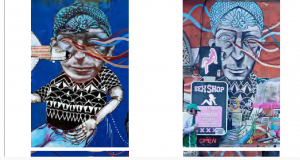Recurring events involving public art have underscored the tension between that expression and the law. Banksy’s “residence” in New York last fall broached this subject, but this summer’s Brooklyn Bridge flag incident, and several new lawsuits asserting copyright in graffiti will test the bounds of what the law protects and what it permits. As Banksy says in one of his murals, "graffiti is a crime."
Graffiti, Vandalism, and Public Expression: Public Art and its Uneasy Relationship with the Law
Topics: Burrow-Giles Lithographic Co. v. Sarony, Ahol Sniffs Glue, David Anasagasti, Steel, City as Canvas, Moral Rights, Argentina, Public Art, Graffiti Art, Philippa Loengard, Visual Artists Rights Act of 1990, Leonardo’s Last Supper, Columbia Law School’s Kernochan Center for Law Med, Chicago, Museum of the City of New York, VARA, Public Expression, Michael Bloomberg, American Eagle, Terry Gilliam, Banksy, 17 U.S.C. § 106A, Copyright, Buenos Aires, 5Pointz, Revok, Roberto Cavalli, vandalism, Reyes, Graffiti, The Atlantic, New York
Argentina, Bond Payment Default, Contempt, and Art Restitution Claims: An Unlikely But Important Mix
When Judge Thomas P. Griesa of the U.S. District Court for the Southern District of New York (Manhattan) held Argentina in contempt on Friday for the South American nation’s default on bond payments, few people likely perked up with attention about the possible implication for art restitution. But with a bit of indulgence, the connection is more important than it might first seem.
Topics: Banco de la Nación, Library, Judge Thomas P. Griesa, Bank of New York Mellon, Argentina, Foreign Sovereign Immunities Act, Rebbe, Southern District of New York, Russian Federation, FSIA, Lubavitch, Restitution, A bond, Foreign Sovereign Immunities, default, Chabad, Paul E. Singer, Art Law Report



